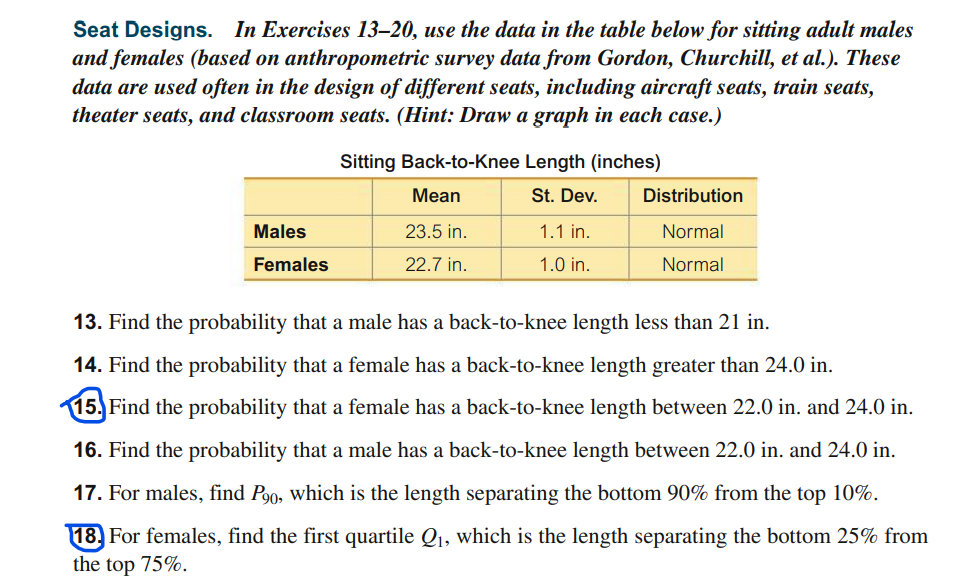18, For females, find the first quartile Qı, which is the length separating the bottom 25% from the top 75%.
18, For females, find the first quartile Qı, which is the length separating the bottom 25% from the top 75%.
Functions and Change: A Modeling Approach to College Algebra (MindTap Course List)
6th Edition
ISBN:9781337111348
Author:Bruce Crauder, Benny Evans, Alan Noell
Publisher:Bruce Crauder, Benny Evans, Alan Noell
Chapter5: A Survey Of Other Common Functions
Section5.3: Modeling Data With Power Functions
Problem 6E: Urban Travel Times Population of cities and driving times are related, as shown in the accompanying...
Related questions
Question
I'm having a hard time with #15 and #18, can you help please?

Transcribed Image Text:Seat Designs. In Exercises 13–20, use the data in the table below for sitting adult males
and females (based on anthropometric survey data from Gordon, Churchill, et al.). These
data are used often in the design of different seats, including aircraft seats, train seats,
theater seats, and classroom seats. (Hint: Draw a graph in each case.)
Sitting Back-to-Knee Length (inches)
Mean
St. Dev.
Distribution
Males
23.5 in.
1.1 in.
Normal
Females
22.7 in.
1.0 in.
Normal
13. Find the probability that a male has a back-to-knee length less than 21 in.
14. Find the probability that a female has a back-to-knee length greater than 24.0 in.
15. Find the probability that a female has a back-to-knee length between 22.0 in. and 24.0 in.
16. Find the probability that a male has a back-to-knee length between 22.0 in. and 24.0 in.
17. For males, find Po0, which is the length separating the bottom 90% from the top 10%.
18. For females, find the first quartile Q1, which is the length separating the bottom 25% from
the top 75%.
Expert Solution
This question has been solved!
Explore an expertly crafted, step-by-step solution for a thorough understanding of key concepts.
This is a popular solution!
Trending now
This is a popular solution!
Step by step
Solved in 2 steps with 2 images

Recommended textbooks for you

Functions and Change: A Modeling Approach to Coll…
Algebra
ISBN:
9781337111348
Author:
Bruce Crauder, Benny Evans, Alan Noell
Publisher:
Cengage Learning

Glencoe Algebra 1, Student Edition, 9780079039897…
Algebra
ISBN:
9780079039897
Author:
Carter
Publisher:
McGraw Hill

Holt Mcdougal Larson Pre-algebra: Student Edition…
Algebra
ISBN:
9780547587776
Author:
HOLT MCDOUGAL
Publisher:
HOLT MCDOUGAL

Functions and Change: A Modeling Approach to Coll…
Algebra
ISBN:
9781337111348
Author:
Bruce Crauder, Benny Evans, Alan Noell
Publisher:
Cengage Learning

Glencoe Algebra 1, Student Edition, 9780079039897…
Algebra
ISBN:
9780079039897
Author:
Carter
Publisher:
McGraw Hill

Holt Mcdougal Larson Pre-algebra: Student Edition…
Algebra
ISBN:
9780547587776
Author:
HOLT MCDOUGAL
Publisher:
HOLT MCDOUGAL

Big Ideas Math A Bridge To Success Algebra 1: Stu…
Algebra
ISBN:
9781680331141
Author:
HOUGHTON MIFFLIN HARCOURT
Publisher:
Houghton Mifflin Harcourt